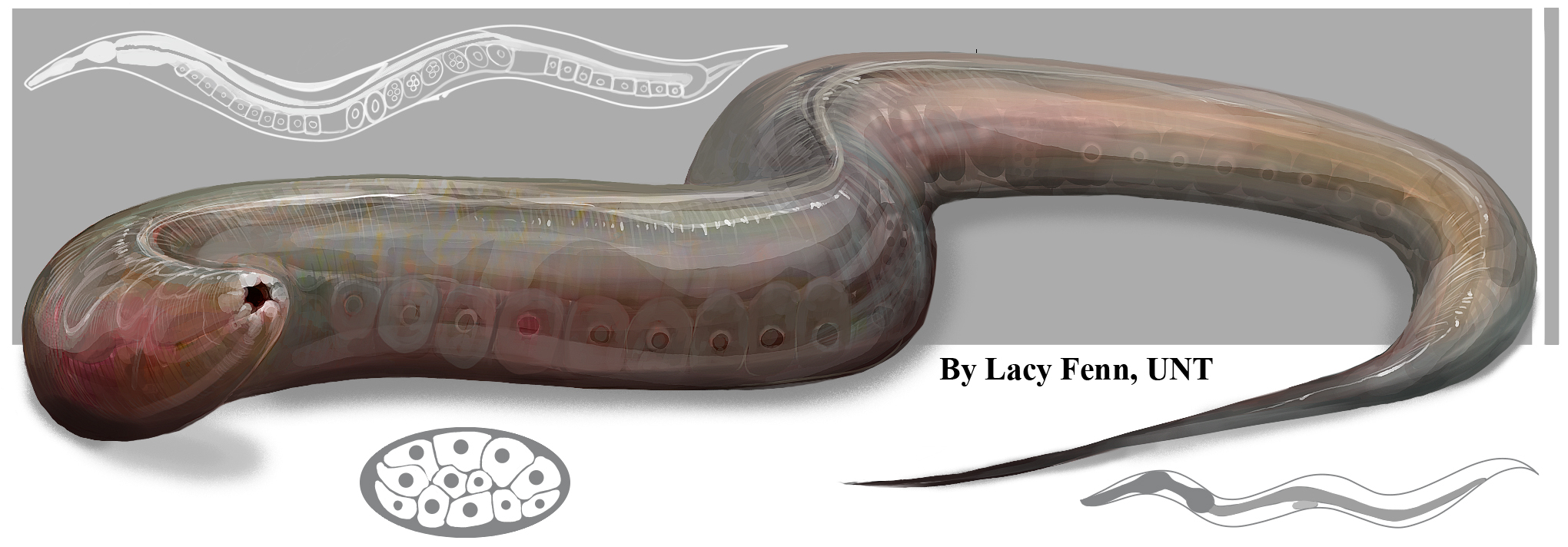 (Artistic drawing of our favorite genetic model system- Caenorhabditis elegans)
(Artistic drawing of our favorite genetic model system- Caenorhabditis elegans)
The nematode Caenorhabditis elegans is used because of the genetic tools available and the ability to control environment and diet.
Impacts of a High Sugar Diet and Altered Ceramides on Oxygen Deprivation Responses
Central to many human health issues is the reduction in tissue oxygen levels (e.g. stroke, cardiac or pulmonary dysfunction, ischemic events and trauma). Organisms, including humans, have evolved various mechanisms to respond to oxygen deprivation; such adaptations include physiological, metabolic and molecular changes. Despite the response and rescue efforts within the organism the lack of oxgen can damage tissues and ultimately cause death. The metabolic abnormalities associated with type 2 diabetes (T2D) (hyperglycemia, increased free fatty acids, insulin resistance) contribute to microvascular and macrovascular dysfunctions, which in-turn lead to reduced oxygen availability and severe health issues (organ dysfunction, tissue damage, blindness and amputations). Given the prevalence of T2D, this is of major human health concern. Studies indicate that vascular dysfunction can lead to an ischemic event (e.g. myocardial, cerebral, limb ischemia) resulting in morbidity and mortality; individuals with T2D have worse recovery when challenged with an ischemic event. Furthermore, human and mammalian studies indicate that altered ceramide lipids in individuals with T2D are key mediators of insulin resistance and linked to ischemic responses. Our recent studies reveal that a sugar-supplemented diet induces oxygen deprivation sensitivity in wild-type animals, compared to animals fed a standard diet. Additionally, a mutation in a gene that codes for ceramide synthase (hyl-2(tm2031)) increased the sensitivity to oxygen deprivation in glucose-fed animals. Our overarching objective is to identify how a sugar-supplemented diet independently or in conjunction with altered cellular ceramide species compromises oxygen deprivation responses. A transcriptomic approach (RNA-sequencing) and genetic screening was taken to determine the molecular changes induced by a glucose diet and ceramide misregulation and why such negatively impacts oxygen deprivation responses. This work is in collaboration with Dr. R. Azad (Bioinformatics).
Impacts of Sugar on Behavior
C. elegans is an amazing system to study the nervous system andbehavior and how such are impacted by the environment. Here we are examining how a sugar diet impacts behavioral responses and if specific neurons are associated with the sensing of sugar. Furthermore, we are interested in determining if a chronic sugar diet impacts the ability for nervous system cells to respond to and survive stress.
Oxygen Deprivation & Hypometabolism
C. elegans, originally isolated in Bristol, England has evolved mechanisms to survive changes in oxygen levels. In fact C. elegans can survive severe oxygen deprivation (hypoxia and anoxia) yet these stresses will impact behavior, growth and development. The C. elegans animal exposed to anoxia will enter into a reversible state of suspended animation in which observable biological processes, such as cell division, development, eating, egg laying, fertilization and movement arrests until air is reintroduced into the environment. Anoxia-induced suspended animation can be maintained for a few days, depending on the developmental stage of exposure; extended anoxia exposures lead to tissue damage and eventually lethality. We are investigating the cellular changes associated with oxygen deprivation at various stages of development as well as in the aging adult animal. Furthermore, we use genetic approaches to identify molecular mechanisms that increase anoxia survival. Understanding oxygen deprivation in a genetic model system such as C. elegans is of interest and can be used to understand many human health related issues (cardiac and pulmonary dysfunction, trauma, diabetes, solid tumor progression etc).
Mitochondrial Function
Mitochondrial function is critical for a wide range of biological processes such as hibernation, torpor, stress resistance, body temperature regulation and lifespan. Our research investigates how sphingolipid/ceramide biosynthesis and iron regulation impact mitochondrial functions, and how these two processes converge to regulate mitochondrial function at the whole animal level. The goal is to dissect the pathways controlling sphingolipid/ceramide metabolism and iron regulation, and to determine if sphingolipid/ceramide metabolism and iron regulation are mechanistically linked. The approach is to use the genetic model system C. elegans to conduct cellular, molecular, and genetic analyses on mutants with altered ceramide biosynthesis and/or iron regulation to test the hypotheses that 1) a central component of mitochondrial function and oxygen deprivation responses, in an intact whole organism, is sphingolipid/ceramide biosynthesis and iron regulation; and 2) sphingolipid/ceramide function and iron regulation are mechanistically linked in mitochondrial functions. Completion of this work will elucidate novel mechanisms regulating mitochondrial function relative to whole animal biology, genotype and environmental stress. This work is in collaboration with Dr. R. Mittler.